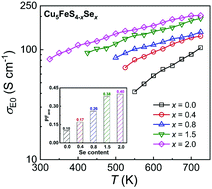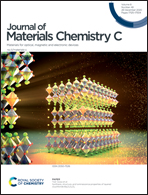Manipulating the phase transformation temperature to achieve cubic Cu5FeS4−xSex and enhanced thermoelectric performance†
Abstract
Cu5FeS4, one of the promising Earth-abundant and low-toxicity Cu-based thermoelectric materials, transforms from an orthorhombic structure to a cubic phase when heated, which may impede its applications at elevated temperatures. Herein, we demonstrate that the phase transformation temperature of Cu5FeS4 can be suppressed to lower temperatures by replacing S by Se, as demonstrated in a series of Cu5FeS4−xSex (x = 0, 0.4, 0.8, 1.5, 2.0) compounds. Upon increasing the Se content x from 0 to 2.0, the phase transformation of Cu5FeS4−xSex takes place at progressively lower temperatures, with Cu5FeS2Se2 having a high cubic structure at room temperature. The Se-substituted Cu5FeS4 compounds achieve tremendously improved electrical performance, which is consistent with the calculated higher transport coefficient and weighted mobility. Combined with the still low lattice thermal conductivity, the Se-substituted Cu5FeS4 compounds achieve improved zT, for example, an improved peak zT of ∼0.6 at 735 K in Cu5FeS3.6Se0.4, and an average zT of ∼0.42 from 300 to 735 K in Cu5FeS2.5Se1.5 that is about 130% higher than that of Cu5FeS4. This study sheds light on enhancement of the thermoelectric performance of Cu5FeS4 based materials via manipulation of their phase transformation temperature.

- This article is part of the themed collection: Journal of Materials Chemistry C HOT Papers


 Please wait while we load your content...
Please wait while we load your content...